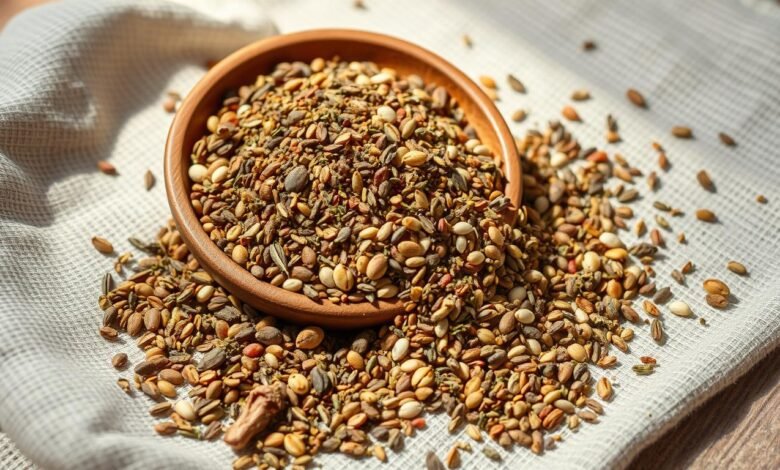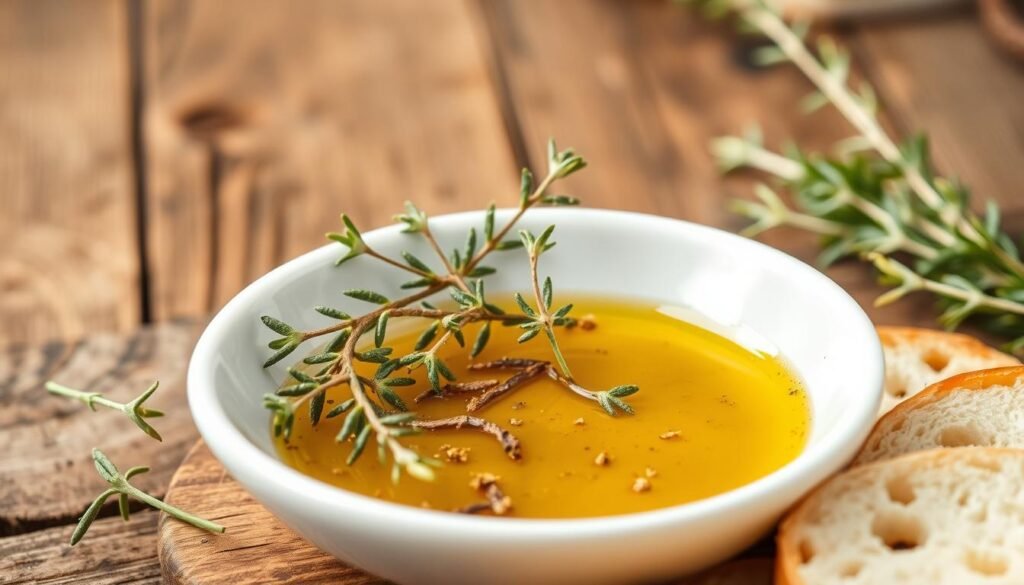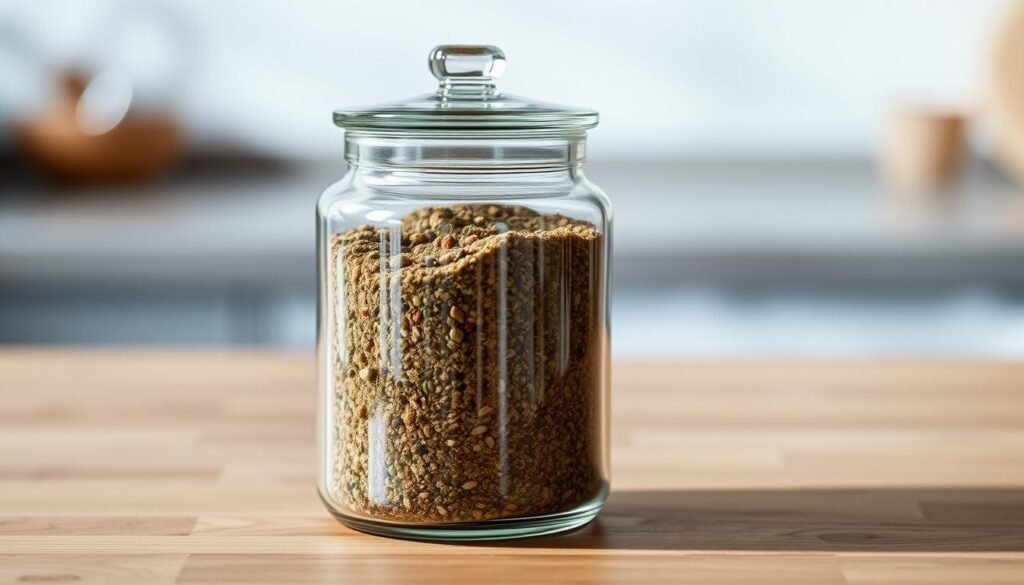
Discover a beloved Middle Eastern blend that lifts simple meals into bright, savory bites. You’ll learn what makes this seasoning aromatic and versatile, from toasted herbs to sesame seeds and tangy sumac.
Use it dry or mixed with olive oil to make dips, dressings, or the classic man’oushe on warm pita. The blend varies by household, so you can tweak herbs, add cumin or coriander, and keep sesame seeds whole for crunchy texture.
In minutes you can toast whole cumin and grind it for depth, then stir the mix with olive oil for dipping or drizzling. Store your jar in an airtight container at room temperature and check sesame freshness—most blends stay vibrant for one to three months.
This guide shows how to customize ratios, boost flavor, and pair the blend with vegetables, proteins, breads, and dairy so your weekly meals feel new.
Key Takeaways
- You’ll know the core ingredients and regional variations.
- Learn quick methods to toast, grind, and mix for deeper flavor.
- Use it both as a dry seasoning and blended with olive oil.
- Follow simple storage tips to keep your jar fresh for months.
- Get serving ideas from pita and dips to roasted vegetables and proteins.
Meet Za’atar: Your Middle Eastern pantry essential
A jar of this aromatic mix is the shortcut you reach for when you want instant Middle Eastern flavor at home.
Za’atar can mean two things: a wild herb in some traditions or, more commonly, the blended mix of dried herbs, sesame, and sumac you see in markets. The blend you buy may taste different from one family to the next, much like regional masalas.
This mix has found a firm foothold in the U.S. as a beloved table seasoning. You’ll often find it served with olive oil and warm bread or sprinkled over labneh, hummus, or baba ganoush.
- Use it as a finishing touch to boost vegetables and proteins.
- Swirl into yogurt or olive oil for quick dips and simple recipes.
- Keep a jar handy—its herbal, tangy character brightens dishes without taking over the plate.
Zaatar Spice
Regional cooks tweak the classic mix, so what you buy in Beirut may taste different from a blend in Cairo.
The core idea stays the same: dried leaves, toasted sesame, salt, and a bright sour note. Common herbs include oregano, thyme, and marjoram. These dried herbs give layered herbal depth and an earthy base.
How it varies across the Middle East
Lebanese-style jars often emphasize sumac and toasted sesame seeds for a fragrant, lemony lift and crunchy texture.
Egyptian or North African versions may add cumin and coriander for warmth and a deeper, earthier profile.
Flavor profile: herbal, nutty, tangy
The overall flavor mixes herbal and earthy notes from the dried leaves with nutty richness from sesame.
Sumac provides an almost lemony tang that brightens the mix and balances the savory elements.
- You’ll learn that it’s both a specific mix and a category with regional variation.
- Sesame adds texture; optional cumin or coriander appear in some family recipes.
- Use this vocabulary to tweak your own blend toward bright, toasty, or warm styles.
Ingredients you’ll need for an authentic za’atar spice blend
Gather a handful of quality dried herbs and a bright tart seasoning to start an authentic blend at home. This makes the mixing step quick and consistent and helps you adjust flavor easily.
Core dried herbs: oregano, thyme, and marjoram
Oregano, thyme, and marjoram form the herbal backbone. Use dried leaves for a stable, long-lasting base.
Sumac: the bright, lemony backbone
Add quality sumac for a tangy zip that sets this mix apart from other blends. Fresh, aromatic sumac defines the bright note you want.
Sesame seeds and salt: nutty crunch and balance
Fold in toasted sesame seeds whole to keep texture. A measured pinch of salt brings out the herbs and balances the tartness.
Optional add-ins and regional twists
- Toasted, ground cumin and coriander for warmer, Egyptian-style depth.
- Aleppo chile flakes for gentle heat without overpowering herbs.
- Hyssop (wild oregano) in some regional blends for a floral hint.
- Always prioritize fresh seeds, quality sumac, and aromatic herbs.
How to make za’atar at home (quick recipe)
Measure the dried herbs into a bowl, add sesame and salt, and you’ll have a ready-to-store blend in minutes.
Mix-and-store method: Place dried oregano, marjoram, thyme, sumac, toasted sesame seeds, and salt in a bowl or jar. Stir until colors and textures look even. Transfer the blend to an airtight container for pantry storage.
Boosted flavor
For depth, toast whole cumin and coriander seeds until fragrant. Let them cool, then grind and fold them into the mix. Keep sesame seeds whole to preserve nutty crunch and avoid oily clumping.
Za’atar olive oil ratios
To make za’atar olive oil, use about 2 parts dry mix to 1 part olive oil for a thick, spreadable paste. Use equal parts mix and oil for a drizzly sauce for salads and dips. Warm the combined dry blend briefly in a skillet if you want toasted aromatics before adding oil.
- Measure herbs and spices directly into a bowl or jar for easy cleanup.
- Label the container with the date to track peak aroma and freshness.
- Adjust oil or mix until the texture spreads or drizzles the way you like.
Pro tips for the best texture and taste
How you crush, taste, and store the blend determines whether it stays lively or dull.
Crushing for even texture
Lightly crush dried thyme so the flakes are smaller and blend evenly with other herbs. Smaller pieces create a uniform mouthfeel and help the mix cling to bread or vegetables.
Balance bitterness
If a jar tastes sharp, reduce thyme and add more oregano or a pinch of salt to round the edge. Taste as you go; a small tweak changes the overall flavor quickly.
Freshness and storage
Avoid grinding sesame — keep the seeds whole to preserve crispness and prevent clumping. Watch the aroma over time; if the nutty scent fades or smells off, make a fresh batch.
- Keep the jar tightly sealed in a cool, dark container.
- Stir before each use so lighter herbs and heavier seeds redistribute.
- Make small batches if you don’t use the blend often so it stays bright.
Document adjustments and you’ll repeat your favorite mix. Use these tips to keep your pantry blend at peak flavor until it’s time to refresh.
Ways to use za’atar in your kitchen today

A small bowl of the blend with olive oil transforms plain bread into a dining moment. Keep it by the stove and reach for it when a simple dish needs bright herbal lift.
Bread, dips, and baked treats
Whisk the mix with olive oil and serve as a dip for crusty bread or use a thick paste over pita before baking for man’oushe. Spoon a little over hummus or baba ganoush to add a tangy, toasty finish.
Dairy and quick appetizers
Drizzle the olive-infused mix over labneh or thick Greek yogurt. Roll soft goat cheese in the dry mix for an easy, herb-forward cheese appetizer.
Proteins, veggies, and snacks
Use the blend as a dry rub or mix with olive oil and citrus to make marinades for kebabs and roasted vegetables. Sprinkle it on roasted chickpeas or popcorn for savory snacks.
Breakfast and salads
Upgrade eggs by sprinkling the mix over fried or scrambled eggs with a final drizzle of olive. Add a pinch to salads with tomato and toasted pita shards for quick fattoush-style flair.
- Keep a small dish of the mix on the counter to finish recipes at a moment’s notice.
Perfect pairings to amplify za’atar’s flavor
Use this classic blend to link simple ingredients and make meals feel composed and bright. You’ll find it plays well across fresh produce, creamy bases, and pantry staples. Keep pairings handy so you can build bowls, toasts, or quick sides in minutes.
Vegetables and herbs that sing
Match it with ripe tomatoes and crisp cucumbers for a refreshing, tangy-herbal combo. Roast eggplant or potatoes and finish with a sprinkle to highlight nutty sesame and lemony notes.
Scatter chopped parsley and mint to echo the blend’s herbal core and add a bright green contrast.
Dairy and grains to carry the mix
Lean on creamy feta, labneh, or plain yogurt to soften tang and add richness. Use pita or pizza dough as carriers—brush dough with olive oil, press the mix on top, and bake until fragrant.
Pantry friends and finishing touches
Combine the mix with olive oil and briny olives for a simple snack board. Add chopped pistachios for crunch and squeeze lemon or lime for lively acidity.
Quick pairing guide
| Ingredient | Best use | Why it works | Serving idea |
|---|---|---|---|
| Tomato | Slice & sprinkle | Juice meets tangy herbs | Tomato salad with olive |
| Feta | Crumble on top | Creamy contrast to tart notes | Flatbread with feta |
| Pita | Brush with oil, bake | Warm bread absorbs flavor | Toasted pita wedges |
| Pistachios | Chop & finish | Add crunch and perfume | Salad or yogurt topping |
Where to buy, how to store, and how long it keeps

Start your search at neighborhood Middle Eastern markets where turnover keeps jars fresh and flavors lively. You can also check specialty shops and online retailers for trusted brands like Villa Jerada if you want a consistent, ready-made option.
Shopping tips for quality purchases
Look for blends with clear ingredient lists that include sumac and sesame seeds. Choose packs that smell fresh when you open them and avoid old, dusty bags.
- Buy from markets that turn inventory quickly to get fresher product.
- Prefer labeled blends from reputable brands or small producers you trust.
- If packaging isn’t resealable, transfer the mix to a clean airtight jar or container at home.
Storage and shelf life
Store your blend in an airtight container at room temperature in a cool, dark place away from heat and light. Sesame seeds carry oils that can turn rancid, so check the jar by smell from time to time.
For peak aroma and flavor, plan to use the mix within 1-3 months. Use a dry spoon to avoid moisture and adjust salt to taste if a purchased mix is too salty.
| Step | What to do | Why it matters | Tip |
|---|---|---|---|
| Buying | Choose markets or Villa Jerada | Fresher product, clear ingredients | Sniff before buying |
| Transfer | Move to a clean jar or container | Prevents air and moisture | Label with fill date |
| Store | Cool, dark place away from stove | Protects delicate oils in seeds | Use within 1–3 months |
| Use | Dry spoon, small batches | Prevents clumps and rancidity | Adjust salt when needed |
Conclusion
za’atar’s core mix of dried herbs, sesame, sumac, and salt makes a versatile middle eastern seasoning that lifts everyday meals. It brightens bread, dips, dairy, vegetables, and proteins with little effort.
Make a quick house blend in minutes. Use 2:1 olive oil for a spreadable paste or 1:1 for a drizzly sauce. Toast whole cumin or coriander for extra depth, and keep sesame seeds whole for crunch.
Store the jar airtight and use within a few months. This simple spice recipe and recipe tips give you a fast, reliable way to finish pita and more. Try small batches and adjust herbs and salt to suit your taste.